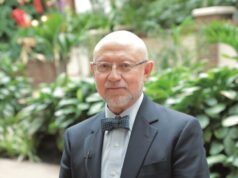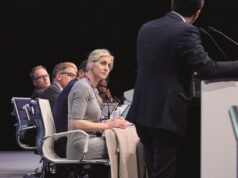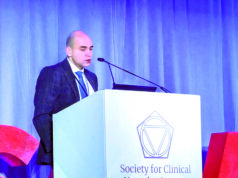
Charting the development of the Charing Cross (CX) venous and lymphatic programme from a sidebar event to becoming an “integral part” of the meeting’s agenda, executive board member Stephen Black (Guy’s and St Thomas’ NHS Foundation Trust and King’s College London, London, UK) highlights the venous education, innovation and evidence that delegates can expect at the 2025 CX Symposium (23–25 April, London, UK).
Black has been involved in the CX venous programme for over a decade, in which time he has witnessed a marked growth of the venous field. This expansion, he says—characterised by a move away from the narrow definition of varicose vein surgery towards “something that offers value to a broad range of patients”—has seen venous become a central pillar of CX. Black also cites the involvement of “world leaders” Erin Murphy (CX co-chair; Carolinas HealthCare System’s Sanger Heart and Vascular Institute, Charlotte, USA), Manj Gohel (Addenbrooke’s Hospital, Cambridge, UK; Imperial College London, London, UK) and Kush Desai (Northwestern University, Chicago, USA) as his co-executive board members in “driving a really high standard of programme” to reflect the field’s evolution.
Education
An educational cornerstone of the CX venous and lymphatic programme and one that has witnessed marked growth is the venous workshop, which provides practical experience for both deep and superficial venous interventions.
Describing this as a “pioneering achievement” of Ian Franklin (London Vascular Clinic, London, UK), Black explains how the workshop offers a “unique opportunity” to delegates in representing a bridge between didactic talks and real-world practice. He encourages CX 2025 attendees to “come and learn something, come and practice it, and go back and do better for patients”.
Innovation
On innovation, Black first steps back from the CX programme to consider wider trends that represent the continued growth of the venous field. For example, promising one-year data on Envveno Medical’s VenoValve were revealed late last year—an innovation Black expresses excitement for.
“A venous valve has been the holy grail of vascular surgery for as long as I can remember,” he says. “For the first time, we’ve got an almost FDA [US Food and Drug Administration]-approved device for treating patients with deep venous reflux, which has been the Achilles’ heel of venous treatment for generations.”
Homing in on some of the innovations set to grace the CX 2025 podium, Black notes those related to the concept of stent maintenance, sharing his opinion on their importance: “In venous, we do things for patients [that have] got to last 50 years. It’s not like arterial disease where the natural morbidity of patients creates an attrition rate that means your horizon for treatment is much shorter. So, maintaining whatever we do for the life of the patient is really important and we’re starting to see a lot more coming that will allow us to do that in a much better way.”
Evidence
Evidence is also central to the CX venous programme, with Black pointing out that the CX 2025 programme includes a plethora of new data, in particular related to venous thromboembolism (VTE) treatments. Black recalls that a considerable development he has seen over the past 10 years has been in the management of VTE. He shares that, in the early days, “nobody believed in it, nobody wanted to treat it”.
At CX 2025, new data are set to move VTE treatment forward. “There will be a couple of podium firsts this year, and in particular STRIKE-PE will be presented for the first time,” Black tells Venous News. He adds that some trial results from the DEXTERITY-AFP study will be presented for the first time, which is looking at acute deep vein thrombosis treatment with adjuncts of steroid delivery to the vessel wall.
Black also points to new randomised controlled trial data on cyanoacrylate glue, set to be presented by Gohel, as another highlight of the CX programme.









